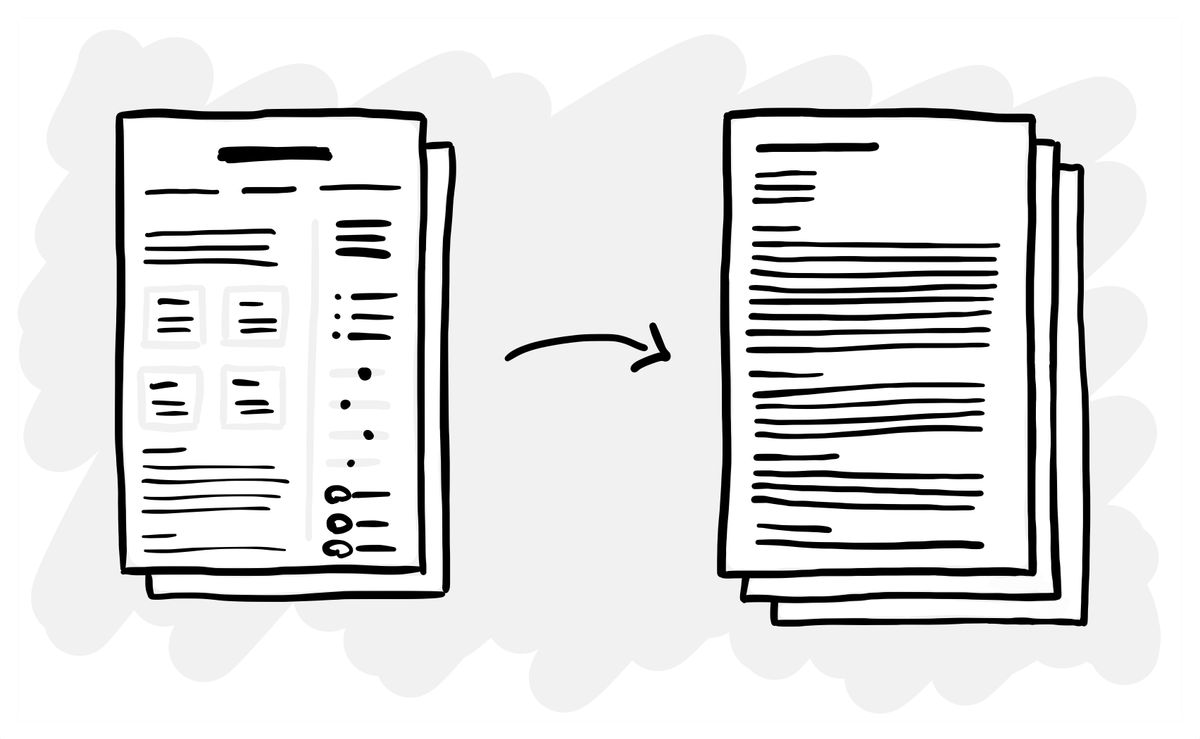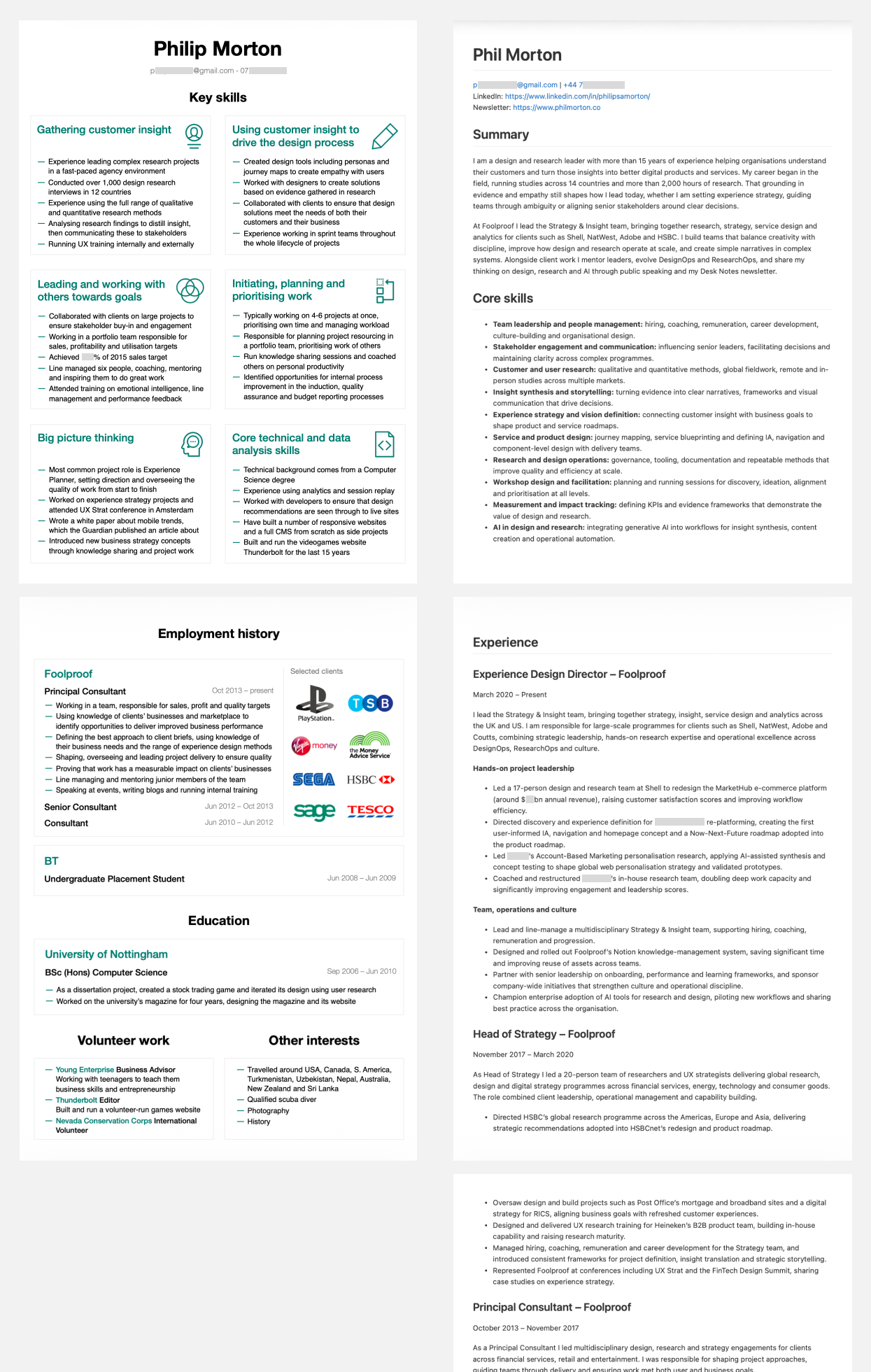How AI is reshaping CVs
The arms race between candidates and recruiters is changing the format of CVs.

If you’ve reviewed CVs in the last year or so, you’ll have noticed something: they look different.
Carefully crafted multi-column designs with skill ratings and company logos are slowly disappearing. In their place are plain, text-heavy documents that look more like they were written for a machine than a human.
That’s because they were.
CVs used to be designed for humans
Not long ago, UXers treated their CV like a mini portfolio piece. People put a lot of effort into the visual design, using layout and typography to make it a pleasant to read and easy to scan. They kept things concise – one or two pages maximum – and included visual elements like company logos to add credibility.
The CV was an artefact designed for human consumption and to get across your personality. You’d have one version that you’d send out for most applications, maybe tweaking a line or two depending on the role.
AI doesn’t care what your CV looks like
We’re in the middle of an arms race in the job market:
- AI makes it much easier for people to apply for more jobs.
- This is driving up the number of applicants for each role.
- Recruiters are responding by leaning more and more on AI to sift through applications.
Imagine that you’re a hiring manager with 200 applications for a position. If it takes you 3 minutes to review each one, it would take 10 hours (with no breaks!) to go through them all.
These days almost all companies use an applicant tracking system (ATS) to make this process easier. Most use AI and ML to triage, rank and filter candidates, assessing CVs to decide who makes it through the first gate.
This has created a vicious cycle where candidates (and AI tools helping them) are adapting CVs to pass automated screening, while recruiters are refining their tools to filter more effectively.
What a CV optimised for machines looks like
1. Layout: from designed artefact to predictable template
These days a CV’s layout needs to be “ATS-friendly”. That means:
- Single-column layouts that are easy for machines to parse.
- Everything in the main column – ATSs disregard content in the header and footer.
- Conventional headings like ‘Experience’, ‘Skills’ and ‘Education’.
- Minimal decorative elements that might confuse text extraction.
2. Stripping back and removing formatting and imagery
AI-powered ATS systems only see text, so logos, icons and profile photos are largely redundant. Now it makes sense to write your CV as plain text first (e.g. in Markdown) and then add a subtle layer of visual identity on top afterwards.
If you want to express your visual design skills and personality, your portfolio and LinkedIn profile are the place to do it instead.
3. Length: less of a constraint than it was
It used to be the case that a CV should be no more than two pages. If you could make it one page, even better for a human to read if you are confident that they’ll read it and be impressed.
Now that your CV’s primary audience is AI, the two-page limit is no longer a hard rule. An ATM isn’t going to skim read – it’s going to read everything. And the more you can give it to read, the better, up to a point.
Obviously you don’t want to go to five or six pages because a human hiring manager is still going to read it, but there’s almost no penalty (if not an advantage) to aiming for three pages.
4. From a single static CV to multiple tailored versions
Manually tailoring your CV for each application used to be laborious, so most people just had one version that they used for every role.
Now candidates can use AI (in something like ChatGPT or a special job hunting tool) to create a CV for each application in a few minutes. They might need to do a quick edit for tone, but otherwise this is a relatively easy task for an LLM to do.
Adding it all up
As an example, here’s my CV from 2016 and then what mine would look like if we applied the principles above.

The 2016 one makes it easy for a human to scan, but there’s no chance it would rank highly in an AI-powered ATS today. The one on the right is much blander, but a machine is going to have no problems parsing it.
Form follows function
For UX folk who spend their careers designing for humans, it might feel counterintuitive to write your CV for a machine, but that’s the world we live in. The CV’s main purpose is now clearing the automated first gate. Creativity is something you show through your portfolio, case studies and interviews.
So the next time you’re updating your CV, remember: you’re not just writing for the hiring manager. You’re writing for the machine that decides whether the hiring manager ever sees it at all.





